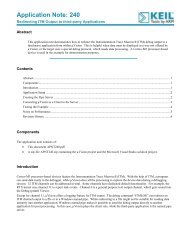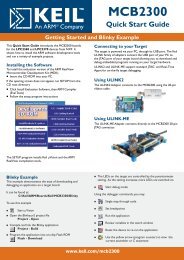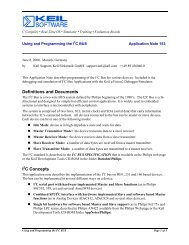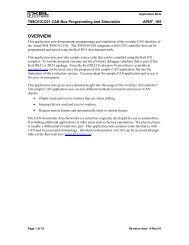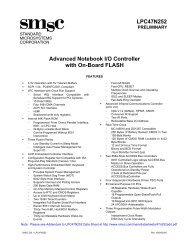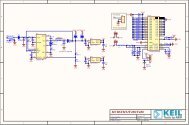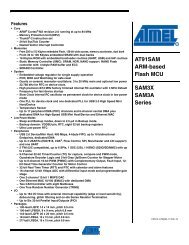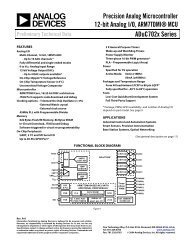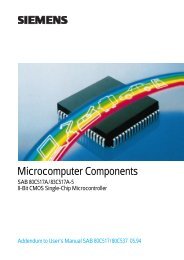NXP 80C552, 83/87C552, P80C562, P83C562 Family Overview - Keil
NXP 80C552, 83/87C552, P80C562, P83C562 Family Overview - Keil
NXP 80C552, 83/87C552, P80C562, P83C562 Family Overview - Keil
You also want an ePaper? Increase the reach of your titles
YUMPU automatically turns print PDFs into web optimized ePapers that Google loves.
Philips Semiconductors<br />
80C51 <strong>Family</strong> Derivatives 8XC552/562 overview<br />
The Control Register, S1CON: The CPU can read from and write<br />
to this 8-bit, directly addressable SFR. Two bits are affected by the<br />
SIO1 hardware: the SI bit is set when a serial interrupt is requested,<br />
and the STO bit is cleared when a STOP condition is present on the<br />
I 2 C bus. The STO bit is also cleared when ENS1 = “0”.<br />
7 6 5 4 3 2 1 0<br />
S1CON (D8H) CR2 ENS1 STA STO SI AA CR1 CR0<br />
ENS1, THE SIO1 ENABLE BIT<br />
ENS1 = “0”: When ENS1 is “0”, the SDA and SCL outputs are in a<br />
high impedance state. SDA and SCL input signals are ignored, SIO1<br />
is in the “not addressed” slave state, and the STO bit in S1CON is<br />
forced to “0”. No other bits are affected. P1.6 and P1.7 may be used<br />
as open drain I/O ports.<br />
ENS1 = “1”: When ENS1 is “1”, SIO1 is enabled. The P1.6 and P1.7<br />
port latches must be set to logic 1.<br />
ENS1 should not be used to temporarily release SIO1 from the I2C<br />
bus since, when ENS1 is reset, the I2C bus status is lost. The AA<br />
flag should be used instead (see description of the AA flag in the<br />
following text).<br />
In the following text, it is assumed that ENS1 = “1”.<br />
STA, THE START FLAG<br />
STA = “1”: When the STA bit is set to enter a master mode, the SIO1<br />
hardware checks the status of the I2C bus and generates a START<br />
condition if the bus is free. If the bus is not free, then SIO1 waits for<br />
a STOP condition (which will free the bus) and generates a START<br />
condition after a delay of a half clock period of the internal serial<br />
clock generator.<br />
If STA is set while SIO1 is already in a master mode and one or<br />
more bytes are transmitted or received, SIO1 transmits a repeated<br />
START condition. STA may be set at any time. STA may also be set<br />
when SIO1 is an addressed slave.<br />
STA = “0”: When the STA bit is reset, no START condition or<br />
repeated START condition will be generated.<br />
STO, THE STOP FLAG<br />
STO = “1”: When the STO bit is set while SIO1 is in a master mode,<br />
a STOP condition is transmitted to the I2C bus. When the STOP<br />
condition is detected on the bus, the SIO1 hardware clears the STO<br />
flag. In a slave mode, the STO flag may be set to recover from an<br />
error condition. In this case, no STOP condition is transmitted to the<br />
I2C bus. However, the SIO1 hardware behaves as if a STOP<br />
condition has been received and switches to the defined “not<br />
addressed” slave receiver mode. The STO flag is automatically<br />
cleared by hardware.<br />
If the STA and STO bits are both set, the a STOP condition is<br />
transmitted to the I2C bus if SIO1 is in a master mode (in a slave<br />
mode, SIO1 generates an internal STOP condition which is not<br />
transmitted). SIO1 then transmits a START condition.<br />
STO = “0”: When the STO bit is reset, no STOP condition will be<br />
generated.<br />
SI, THE SERIAL INTERRUPT FLAG<br />
SI = “1”: When the SI flag is set, then, if the EA and ES1 (interrupt<br />
enable register) bits are also set, a serial interrupt is requested. SI is<br />
set by hardware when one of 25 of the 26 possible SIO1 states is<br />
1996 Aug 06 16<br />
entered. The only state that does not cause SI to be set is state<br />
F8H, which indicates that no relevant state information is available.<br />
While SI is set, the low period of the serial clock on the SCL line is<br />
stretched, and the serial transfer is suspended. A high level on the<br />
SCL line is unaffected by the serial interrupt flag. SI must be reset<br />
by software.<br />
SI = “0”: When the SI flag is reset, no serial interrupt is requested,<br />
and there is no stretching of the serial clock on the SCL line.<br />
AA, THE ASSERT ACKNOWLEDGE FLAG<br />
AA = “1”: If the AA flag is set, an acknowledge (low level to SDA) will<br />
be returned during the acknowledge clock pulse on the SCL line<br />
when:<br />
– The “own slave address” has been received<br />
– The general call address has been received while the general call<br />
bit (GC) in S1ADR is set<br />
– A data byte has been received while SIO1 is in the master<br />
receiver mode<br />
– A data byte has been received while SIO1 is in the addressed<br />
slave receiver mode<br />
AA = “0”: if the AA flag is reset, a not acknowledge (high level to<br />
SDA) will be returned during the acknowledge clock pulse on SCL<br />
when:<br />
– A data has been received while SIO1 is in the master receiver<br />
mode<br />
– A data byte has been received while SIO1 is in the addressed<br />
slave receiver mode<br />
When SIO1 is in the addressed slave transmitter mode, state C8H<br />
will be entered after the last serial is transmitted (see Figure 20).<br />
When SI is cleared, SIO1 leaves state C8H, enters the not<br />
addressed slave receiver mode, and the SDA line remains at a high<br />
level. In state C8H, the AA flag can be set again for future address<br />
recognition.<br />
When SIO1 is in the not addressed slave mode, its own slave<br />
address and the general call address are ignored. Consequently, no<br />
acknowledge is returned, and a serial interrupt is not requested.<br />
Thus, SIO1 can be temporarily released from the I2C bus while the<br />
bus status is monitored. While SIO1 is released from the bus,<br />
START and STOP conditions are detected, and serial data is shifted<br />
in. Address recognition can be resumed at any time by setting the<br />
AA flag. If the AA flag is set when the part’s own slave address or<br />
the general call address has been partly received, the address will<br />
be recognized at the end of the byte transmission.<br />
CR0, CR1, AND CR2, THE CLOCK RATE BITS<br />
These three bits determine the serial clock frequency when SIO1 is<br />
in a master mode. The various serial rates are shown in Table 2.<br />
A 12.5kHz bit rate may be used by devices that interface to the I2C bus via standard I/O port lines which are software driven and slow.<br />
100kHz is usually the maximum bit rate and can be derived from a<br />
16MHz, 12MHz, or a 6MHz oscillator. A variable bit rate (0.5kHz to<br />
62.5kHz) may also be used if Timer 1 is not required for any other<br />
purpose while SIO1 is in a master mode.<br />
The frequencies shown in Table 2 are unimportant when SIO1 is in a<br />
slave mode. In the slave modes, SIO1 will automatically synchronize<br />
with any clock frequency up to 100kHz.



